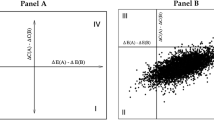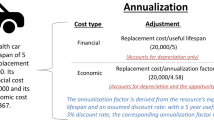Abstract
The concept of need is central to the non-market allocation of many public resources, although the definition of need to serve as a basis for such resource allocation often remains contested. This study uses a discrete-choice experiment to investigate the general public’s interpretation of need in the context of health care resource allocation, focusing on three commonly cited definitions of need: need as a person’s baseline health status; need as a person’s ability-to-benefit; and need as the amount of resources required to exhaust a person’s ability-to-benefit. Analysis of participants’ need judgments using a latent-class, rank-ordered conditional logit model reveals that most individuals draw on all three definitions when assessing need, and that here is heterogeneity in interpretations of need among the public. Baseline health status is the most influential and consistent determinant of need, while ability-to-benefit and resources-required-to-exhaust-benefit are considered jointly. However, while some assign greater need to those who are worse off in the sense that they have little ability-to-benefit and require large amounts of resources to achieve that benefit, others assign greater need to those who have greater ability-to-benefit and whose benefit can be achieved with small amounts of resources. The public’s reasoning about need contrasts sharply in a number of ways with the types of arguments offered in the literature on needs-based resource allocation.


Notes Reference combination: (pain free \(=\) 0, pain relief \(=\) 24 and pills \(=\) 12). All probabilities are conditional on class

Notes Reference combination: (pain free \(=\) 0, pain relief \(=\) 24 and pills \(=\) 12). All probabilities are conditional on class

Notes Reference combination: (pain free \(=\) 0, pain relief \(=\) 24 and pills \(=\) 12). All probabilities are conditional on class

Notes Reference combination: (pain free \(=\) 0, pain relief \(=\) 24 and pills \(=\) 12). All probabilities are conditional on class
Similar content being viewed by others
Notes
Nuances, of course, do arise. The resources required to address a housing need for a physically disabled individual differ from an able-bodied individual. But because these claims pertain to shared, basic material human needs relative to a common material standard within a society the material resources required and their effectiveness are, except for unusual circumstances, similar across individuals. Further, such measures abstract from preferences—a homeless person may prefer to not live in a traditional dwelling—but these preferences do not alter the assessed need for housing.
In our setting, participants are first asked who has the greatest need, so the choice set for this decision is all three alternatives; they are then asked who has the least need, so the choice set for this decision is the two remaining alternatives.
Estimation is performed using both the ML and EM algorithms.
Of those classified as inconsistent, only 10% missed both; 90% missed only a single test question.
Results for the full sample and for models with interaction terms are listed in on-line Appendices 3 and 4.
All probabilities are conditional probabilities, i.e., conditional on falling into the noted class.
Results for class 4 in the full sample differ slightly: the gradient for baseline health is similarly shallow and the effects for ATB and RREB modest, but there is a modest negative relationship between need and ATB and a positive relationship between need and RREB. Such differences associated with the inclusion of inconsistent individuals suggests that the shallow gradient for baseline health is the key distinguishing characteristic of Class 4.
Tests for independence (based on Spearman’s rank correlation and Kendall’s Tau statistic) between the levels of these attributes specified in the survey scenarios failed to reject the null hypothesis of independence (p \(=\) 0.41 and 0.43 respectively).
References
Abelson J, Lomas J, Eyles J, Birch S, Veenstra G (1995) Does the community want devolved authority? Results of deliberative polling in Ontario. Can Med Assoc J 153:403–412
Ahlert M, Funke K, Schwettmann L (2013) Thresholds, productivity, and context: an experimental study of determinants of distributive behaviour. Soc Choice Welf 40(4):957–984
Allison PD, Christakis N (1994) Logit models for sets of ranked items. Sociol Methodol 24:199–228
Boulding KE (1966) The concept of need for health services. Milbank Q 44(4):202–223
Braybrooke D (1987) Meeting needs. Princeton University Press, Princeton, N.J.
Cappelen AW, Moene K, Sorensen E, Tungodden B (2013) Needs vesus entitlements—an international fairness experiment. J Eur Econ Assoc 11(3):574–598
Cuadras-Morato X, Pinto-Prades JL, Abellan-Perinoan JM (2001) Equity considerations in health care: the relevance of claims. Health Econ 10:187–205
Culyer AJ (1995) Need: the idea won’t do—but we still need it. Soc Sci Med 40(6):727–730
Culyer AJ, Wagstaff A (1993) Equity and equality in health and health care. J Health Econ 12(4):431–457
Daniels N (1985) Just Health Care. Cambridge University Pres, Cambridge
Daniels N (2008) Just health: meeting health needs fairly. Cambridge University Press, New York, NY
Deutsch M (1985) Distributive justice. Vail-Ballou Press, Binghamton, N.Y.
Dillman DA (2009) Response rate and measurement differences in mixed mode surveys using mail, telephone, interactive voice response and the internet. Soc Sci Res 38(1):1–18
Evans RG (1984) Strained mercy: the economics of Canadian health care. Buttersworth, Toronto
Frohlich N, Oppenheimer JA (1992) Choosing justice: an experimental approach to ethical theory. University of California Press, Berkeley, CA
Gaertner W, Schokkaert E (2012) Empirical social choice. Cambridge University Press, Cambridge
Gajic A, Cameron D, Hurley J (2012) Cost-effectiveness of cash versus lottery incentives for a web-based, stated preference survey. Eur J Health Econ 13(6):99–789
Greene W, Hensher D (2003) A latent class model for discrete choice analysis: contrasts with mixed logit. Transp Res Part B Methodol 37(8):681–698
Gu Y, Lanscar E, Ghijben P, Butler J, Donaldson C (2015) Attributes and weights in health care priority setting: a systematic review of what counts and to what extent. Soc Sci Med 146:41–52
Hasman A, Hope T, Osterdal L (2006) Health care need: three interpretations. J Appl Philos 23(2):145–156
Herlitz A, Horan D (2016) Measuring need for priority setting in health care planning and policy. Soc Sci Med 157:96–102
Hope T, Osterdal L, Hasman A (2010) An inquiry into the principles of needs-based allocation of health care. Bioethics 24(9):470–480
Hurley J (2000) An overview of the normative economics of the health sector. In: Culyer AJ, Newhouse JP (eds) Handbook of health economics. Elsevier Science B.V, Amsterdam, pp 55–118
Hurley J, Buckley N, Cuff K, Giacomini M, Cameron D (2011) Judgments regarding the fair division of goods: the impact of verbal versus quantitative descriptions of alternative principles. Soc Choice Welf 37(2):341–372
Juth N (2015) Challenges for principles of need in health care. Health Care Anal 23:73–87
Kahneman D, Varey C (1991) Notes on the psychology of utility. In: Elster J, Roemer J (eds) Interpersonal comparisons of well-being. Cambridge University Press, Cambridge, pp 127–163
Konow J (2001) Fair and square: the four sides of distributive justice. J Econ Behav Organ 46(2):64–137
Konow J (2003) Which is the fairest of all? A positive analysis of justice theories. J Econ Lit 41(4):1188–1239
Kuhfeld W (1997) Efficient experimental design using computerized search. SAS Institute, Sawtooth Software Research Paper Series, Sequim, WA
Kuhfeld WF (2005) Marketing research methods in SAS. SAS Institute Inc, Cary, North Carolina
Luce RD (1959) Individual choice behavior: a theoretical analysis. Dover, New York
Manfreda L, Bosnjak M, Hass J, Vehovar V (2008) Web surveys versus other survey modes: a meta-analysis comparing response rates. Int J Market Res 50:79–104
McFadden D (1974) Conditional logit analysis of qualitative choice behavior. Frontiers in econometrics. Academic Press, New York
Mentzakis E, Stefanowska P, Hurley J (2011) A discrete choice experiment investigating preferences for funding drugs used to treat orphan diseases. Health Econ Policy Law 6(3):405–433
Miller D (1976) Social justice. Clarendon Press, Oxford
Robertson A (1998) Critical reflections on the politics of need: implications for public health. Soc Sci Med 47(10):1419–1430
Schwettmann L (2009) Trading off competing allocation principles: theoretical approaches and empirical investigations. Peter Lang GmbH, New York
Scott JT, Matland R, Michelbach P, Bornstein B (2001) Just desserts: an experimental study of distributive justice norms. Am J Polit Sci 45(4):749–767
Shah KK (2009) Severity of illness and priority-setting in health care: a review of the literature. Health Policy 93:77–84
Skitka LJ, Tetlock PE (1992) Allocating scarce resources: a contingency model of distributive justice. J Exp Soc Psychol 28(6):491–522
Smith R (2007) Use, option and externality values: are contingent valuation studies in health care mis-specified? Health Econ 16(8):861–869
Swait J, Adamowicz W (2001) The influence of task complexity on consumer choice: a latent class model of decision strategy switching. J Consum Res 28(1):135–148
Thokala DA (2012) Multiple criteria decision analysis for health technology assessment. Value Health 15:1172–1181
van Doorslaer E, Wagstaff A, Rutten F (1993) Equity in the finance and delivery of health care: an international perspective. Oxford University Press, Oxford
van Exel J, Baker R, Mason H, Donaldson C, Brouwer W (2015) Public views on principles for health care priority setting: findings of a European Cross-Country Study using Q methodology. Soc Sci Med 126:128–137
Whitty J, Lanscar E, Rixon K, Golenko X, Ratcliffe J (2014) A systematic review of stated preference studies reporting public preferences for health care priority setting. Patient 7:365–386
Williams A (1978) Need—an economic exegesis. In: Culyer A, Wright K (eds) Economic aspects of health services. Martin Robertson, London, pp 32–45
Yaari ME, Bar-Hillel M (1984) On Dividing Justly. Soc Choice Welf 1:1–24
Zwerina K, Huber J, Kuhfeld WF (1996) A general method for constructing efficient choice designs. SAS Technical Papers: TS-722E, SAS Inc., Cary, North Carolina
Author information
Authors and Affiliations
Corresponding author
Ethics declarations
Conflict of interest
The authors have no conflicts to declare.
Additional information
This research was funded by grant # 76670 from the Canadian Institutes of Health Research and by grant #2045 from the Government of Ontario through the Ministry of Health and Long-Term Care Health System Research Fund. The views expressed in this paper are those of the authors and should not be taken to represent the views of the Government of Ontario. We thank Neil Buckley, Anthony Culyer, Kate Cuff, Stuart Mestelman, Andrew Muller, and Jingjing Zhang and two anonymous referees for helpful comments, and Dave Cameron and Aleksandra Gajic for excellent research assistance. Any errors are our own.
Electronic supplementary material
Below is the link to the electronic supplementary material.
Rights and permissions
About this article
Cite this article
Hurley, J., Mentzakis, E., Giacomini, M. et al. Non-market resource allocation and the public’s interpretation of need: an empirical investigation in the context of health care. Soc Choice Welf 49, 117–143 (2017). https://doi.org/10.1007/s00355-017-1053-9
Received:
Accepted:
Published:
Issue Date:
DOI: https://doi.org/10.1007/s00355-017-1053-9




